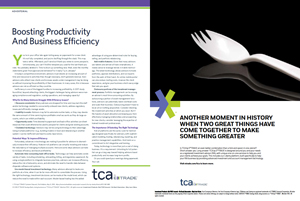 You’re in your office late again toiling away on paperwork for a new client. It’s not fully completed, and you’re shuffling through the stack. This may take a while. Afterward, you’ll send out thank-you notes to some prospects. Unfortunately, you can’t find the template you used for the last thank-you note. You probably deleted it. Time to drum up something new. Wait, were the monthly statements given final approval and delivered? Is it really 7 p.m. already?
You’re in your office late again toiling away on paperwork for a new client. It’s not fully completed, and you’re shuffling through the stack. This may take a while. Afterward, you’ll send out thank-you notes to some prospects. Unfortunately, you can’t find the template you used for the last thank-you note. You probably deleted it. Time to drum up something new. Wait, were the monthly statements given final approval and delivered? Is it really 7 p.m. already?
In today’s competitive environment, advisors must devote an increasing amount of time and resources to activities that, though necessary, don’t generate revenue. Even advisors who attract new clients and increase assets under management may be doing so without improving the profitability of their businesses. In many cases, this is because advisors are not as efficient as they could be.
Inefficiency is one of the biggest hurdles to increasing profitability. A 2017 study found that, beyond attracting clients, the biggest challenges facing advisors were managing compliance and regulation, scaling operations, and managing capacity.1
Why Do So Many Advisors Struggle With Efficiency Issues?
• Resource constraints: Many advisors are strapped for time and may lack the staff and/or technology needed to concurrently onboard new clients, address regulatory issues,and efficiently manage assets.
• Inability to scale: Advisors may fail to automate routine tasks, or they may devote the same amount of time servicing less-profitable small accounts as they do large accounts, which can inhibit profitability.
• Opportunity costs: Time devoted to paperwork and back-office activities can divert resources that could otherwise be used to prospect for clients and grow existing accounts.
• Outdated technology: Advisors may not be using technology to their advantage.
Using multiple platforms—e.g., building models in Excel and rebalancing in another system—can be inefficient and lead to costly input errors.
Potential Ways To Improve Efficiency
Fortunately, advances in technology are making it possible for advisors to dramatically increase their efficiency. Feature-rich platforms can simplify investing and reduce the redundancy of managing multiple accounts. Here are some steps advisors can take to increase efficiency and boost profitability:
Automate time-consuming back-office tasks. Technology can help automate a wide variety of tasks, including scheduling, onboarding, billing, and regulatory paperwork. By using a single platform to integrate business practices, advisors can increase efficiency, reduce the risk of data entry errors, and eliminate the need to transfer data between disparate software and systems.
Use model-based investment technology. Many advisors attempt to trade one portfolio at a time, when it can be far more efficient to consolidate the process. Using the right technology, investment decisions can be made at the model level, which can reduce the need to trade within each account. Model-based trading has the added advantage of using pre-determined rules for buying, selling, and portfolio rebalancing.
Add mobile features. Given that many advisors use tablets and almost all have smartphones, it makes sense to leverage trends in mobile technology. The latest technology allows advisors to trade portfolios, approve distributions, and run reports from the palm of their hand. An online mobile portal can also reduce mailing costs, improve the client experience, and give your business a tech-savvy edge that sets you apart.
Outsource portions of the investment management process. Portfolio management can be among an advisor’s most time-consuming activities. By outsourcing a portion of asset management functions, advisors can potentially lower overhead costs and scale their business. Outsourcing doesn’t have to be an all-or-nothing proposition. Consider retaining the investment activities at which you excel. But if the hassles of asset allocation are keeping you from effectively managing relationships and prospecting for new clients, consider leveraging the expertise of trained investment professionals.
The Importance Of Selecting The Right Technology
Not all platforms are the same. Look for technology designed specifically for advisors, with sophisticated modeling, trading, rebalancing, reporting, and practice management capabilities. And insist on a commitment to full integration and training.
Today, technology is more than just a cost of doing business. It’s a requirement. Unlocking its full potential can go a long way toward helping advisors boost productivity and increase long-term profits.
Or you could spend your evenings doing paperwork.
Your call.

1. TCA by E*TRADE Customer Research, TechValidate, May 8, 2018, https://www.techvalidate.com/product-research/tca-by-etrade/charts/A55-06E-8B8. © 2018 E*TRADE Savings Bank, doing business as “TCA by E*TRADE.” Member FDIC. All rights reserved. Investment Products: Not FDIC Insured - No Bank Guarantee - May Lose Value.
 ANOTHER MOMENT IN HISTORY WHEN TWO GREAT THINGS HAVE COME TOGETHER TO MAKE SOMETHING GREATER
ANOTHER MOMENT IN HISTORY WHEN TWO GREAT THINGS HAVE COME TOGETHER TO MAKE SOMETHING GREATER
Is TCA by E*TRADE an even better combination than a fork and spoon in one utensil? Short answer: yes. Long answer: TCA by E*TRADE is designed around you and your needs as a registered investment advisor (RIA), with unique one-on-one services to help you and your clients achieve your goals. This includes our Liberty platform, built specifically to help your RIA business by providing advanced investment and account management technology.
Visit etrade.com/tca to learn more.
Investment Products: Not FDIC Insured - No Bank Guarantee - May Lose Value. Trust Company of America, the Trust Company of America logo, TCAdvisor and Liberty are registered trademarks of E*TRADE Financial Corporation. All other trademarks mentioned herein are the property of their respective owners. Product and service offerings are subject to change without notice. ©2018 E*TRADE Savings Bank, doing business as “TCA by E*TRADE”, Member FDIC. All rights reserved.








